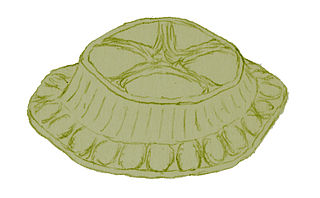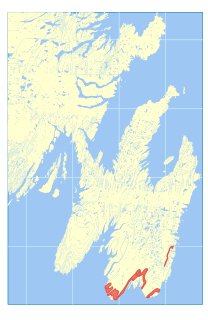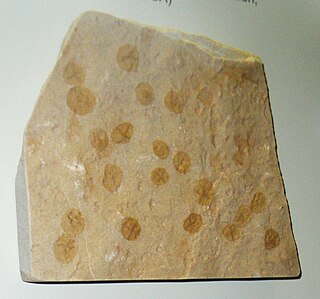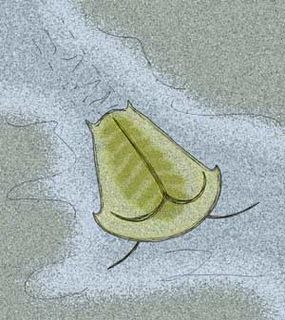 W
WArkarua adami is a small, Precambrian disk-like fossil with a raised center, a number of radial ridges on the rim, and a five-pointed central depression marked with radial lines of 5 small dots from the middle of the disk center. Fossils range from 3 to 10 mm in diameter.
 W
WThe Briscal Formation is a geologic formation in Newfoundland and Labrador. It preserves fossils dating back to the Ediacaran period.
 W
WBurykhia hunti is a Precambrian fossil from the White Sea region of Russia dating to 555 million years ago. It is considered of ascidian affinity, due to the sac-like morphology and a series of distinctly perforated bands reminiscent of a tunicate pharynx. If B. hunti is a tunicate, it could be the oldest ascidian fossil known as of its publication in 2012. It is possibly related to the slightly younger Ausia, another putative ascidian from the Vendian biota in Namibia. In the case of Burykhia, the narrow longitudinal vessels support affinity with the suborder Phlebobranchia.
 W
WThe Conception Group is a geologic group in Newfoundland and Labrador. It preserves fossils dating back to the Ediacaran period. It mainly contains turbidites, but is interrupted by a glacial diamictite, and tops out with sand and siltstones . It corresponds to the lower portion of the Connecting Point Group
 W
WCorumbella is an extinct genus of terminal-Ediacaran cnidarians. It is the only genus in the monotypic family Corumbellidae, and is represented by a single species Corumbella werneri. It possessed a carapace made up of thick polygonal rings in which plates with pores and papillae attest to the advent of skeletogenesis in latest Neoproterozoic metazoan. It was a sessile predator and somewhat resembles the later conulariids.
 W
WDickinsoniidae is a taxon of Ediacaran fossils with an airbed-like quilted morphology, sometimes found in association with bizarre trace fossils. It is placed within the extinct phylum Proarticulata, and contains the defined genera Dickinsonia and probably Windermeria. Phyllozoon is associated with this family, and is thought to represent ichnofossils of Dickinsonia.
 W
WThe Drook Formation is a geologic formation in Newfoundland and Labrador. It preserves fossils dating back to the Ediacaran period. It contains a stratum dated to 575.8 ± 0.5 million years ago.
 W
WThe Erniettomorphs are a form of Ediacaran fossil consisting of rows of airbed-like tubes arranged along a midline with a glide symmetry. Representative genera include Ernietta, Phyllozoon, Pteridinium, Swartpuntia and possibly Dickinsonia. Undisputed Erniettomorphs were Ediacaran, but the species Erytholus, Rutgersella, and Protonympha, who have by some been included in this group but are by no means clear members, are found through to the Late Devonian. Their affinity is uncertain; they probably form a clade and are most likely a sister group to the rangeomorphs, which bear a similar construction. Placements within the metazoan crown-group have been rebutted, and it is most likely that these peculiar organisms lie in the stem group to the animals. There is no evidence that they possessed a mouth or gut. Because they may have been found in water which was too deep to permit photosynthesis - and in some cases, lived half-buried in sediment, it is speculated that they fed by osmosis from the sea water. Such a lifestyle requires a very high surface area to volume ratio - higher than is observed in fossils. However, this paradox can be resolved if much of the volume of the organisms was not metabolically active. Many Pteridinium fossils are found completely filled with sand; if this sand were present within the organism while it was alive, this would reduce its metabolically active volume enough to make osmotic feeding viable.
 W
WFedomia is a genus of organisms resembling sea sponges from the Ediacaran Period.
 W
WThe Fermeuse Formation is a fossil-bearing Ediacaran geologic formation in Newfoundland.
 W
WThe Gaskiers Formation is a geologic formation in Newfoundland and Labrador. It preserves fossils dating back to the Ediacaran period.
 W
WLossinia lissetskii is a fossil marine organism from Precambrian strata of the White Sea area, in Russia. L. lissetskii is a member of the extinct phylum Proarticulata.
 W
WMawsonites is a fossil genus dating to the Ediacaran Period from 630 – 542 million years ago during the Precambrian era. The fossils consist of a rounded diamond shape, made up from lobes radiating out from a central circle roughly 12 cm in diameter. There are about 19 radiations from the central circle.
 W
WNimbia occlusa is a form of Ediacaran fossil shaped like a circular or oval disk, with a thick rim around the margin. Within the rim the fossil is usually flat, but may have a central nipple or dimple. These fossils were generally believed to be those of cnidarians, but they have since been reinterpreted as structures made by microbial colonies. They can reach up to 6 cm in diameter, with a centimeter-thick rim. Some fossils are distorted.
 W
WObamus coronatus is a torus-shaped Ediacaran fossil from the Rawnsley Quartzite of South Australia named in honor of former American President Barack Obama.
 W
WOtavia antiqua is an early sponge-like fossil found in Namibia in the Etosha National Park. It is claimed to be the oldest animal fossil, being found in rock aged between 760 and 550 million years ago. The genus was named after the Otavi Group in which the fossils were found. The oldest fossils are from the Tonian period, before the Cryogenian glaciations, but the latest found were from the Nama Group rocks, which are from the Ediacaran period.
 W
WPectinifrons was a rangeomorph, a member of the Ediacara biota found at Mistaken Point, Newfoundland.
 W
WPhyllozoon is an Ediacaran imprint that resembles a proarticulatan and has been interpreted as a feeding trace. It usually occurs in long chains of imprints formed, presumably as the organism that made it moved.
 W
WPlanolites is an ichnogenus found throughout the Phanerozoic that is made during the feeding process of worm-like animals. The traces are generally small, 1–5 mm (0.039–0.197 in), unlined, and rarely branched, with fill that differs from the host rock.
 W
WPrimocandelabrum is a genus of rangeomorph known from the Avalon-type Ediacaran biota. It makes up the brunt of some bedding plane assemblages. Primocandelabrum was described by Hofmann, O'Brien, and King in 2008.
 W
WRangea is a frond-like Ediacaran fossil with six-fold radial symmetry. It is the type genus of the rangeomorphs.
 W
WThe Renews Head Formation is a geologic formation in Newfoundland and Labrador. It preserves fossils dating back to the Ediacaran period.
 W
WSkania is a Middle Cambrian fossil arthropod that is closely related to the Early Cambrian Primicaris larvaformis from the Chengjiang Biota, China. It bears a superficial resemblance to the Ediacaran organism Parvancorina. A single specimens of Skania are known from the Greater Phyllopod bed, where they comprise < 0.01% of the community. While previously enigmatic, it is now thought to be a marrellomorph.
 W
WThe St John's Group is a fossiliferous shale-dominated Ediacaran geologic group in Newfoundland and Labrador, younger than 565 ± 3 million years ago.
Tamga hamulifera is a disk-shaped fossil from Precambrian strata of the White Sea area, in Russia.
 W
WThe Trepassey Formation is a geologic formation that crops out in Newfoundland. It preserves fossils dating back to the Ediacaran period.
 W
WVendotaenids are ribbon-shaped, carbonaceous, Precambrian macrofossils. They are thought to represent giant sulfide-reducing bacteria, similar to Thiomargarita. Many form genera, including Vendotaenida, have been described.
 W
WYarnemia ascidiformis is a fossil tentatively classified as a tunicate. While Y. ascidiformis looks similar to tunicates, the oldest unequivocal tunicate, Shankouclava dates to the Cambrian period, while Y. ascidiformis is Ediacaran in age.